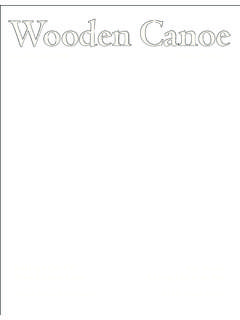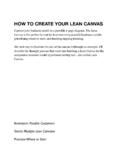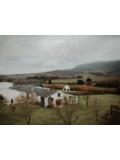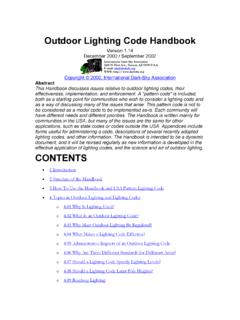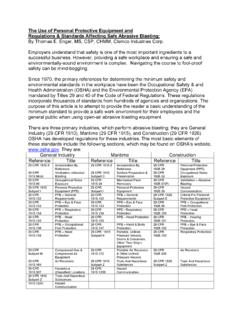Transcription of Dacron–A Canvas Alternative - Stewart River Boatworks
1 Wooden CanoeA clothes iron and a temperature calibrator are essential to the job; a small tacking iron is also handy to have. All photos: Alex A Canvas Alternativeby Alex CombThere was a time when most aircraft were built by covering a wood framework with fabric. Perhaps the idea came, in part, from the Canvas -covered canoe, which of course was already well established as the most efficient way to build a light weight craft. Interesting-ly enough, both craft were later built with thin aluminum sheeting over aluminum ribs. Despite all the changes in technology in both the marine and aircraft industries over the ensuing years, the fabric-covered canoe and the fabric-covered aircraft have survived as viable two types of craft have followed similar paths for obvious reasons. Builders of both have a fundamen-tal interest in maximizing strength while at the same time keeping weight to a minimum. In the early days of cloth-covered aircraft, a light-weight cotton, very similar to what is called Egyptian cotton, was used.
2 This high thread-count, finely-woven fabric was both strong and light factors which earned it the moniker aircraft cot-ton. At that time, canoes were being built with heavy woven cotton duck. While canoes don t need to get off the ground, they may need to fend off an unexpected rock, so the heavy duck had seemed appropriate. Some canoe builders, however, were lured by the light weights offered with the aircraft construction. Penn Yan Boat Company in upstate New York was an early experimenter in build-ing lightweight canoes and car-top row- and motorboats and adapted a system using lighter cotton treated with an airplane dope filler to ren-der the fabric weatherproof. Charles Herrmann, the company founder, began his career in the aviation in-dustry and saw value in transferring some of its technology to his new enterprise. With E. I. du Pont de Nemours and Company s development of the proprietary fabric known as Dacron in 1951, aircraft manufacturers found a fabric that could provide similar strength to cotton but at a lower weight and without the worry of rot.
3 Soon aircraft cotton was replaced with aircraft Dacron. Dacron has also proved a very serviceable and lighter-weight substitute for Canvas in waterproofing a canoe hull. Chemically, Dacron, which is DuPont s trade name for the fabric, is the compound polyethylene terephthalate, although it quickly became known as polyester. Two brand-name polyester fabrics developed for the aircraft industry are Ceconite and Poly-Fiber. Each comes in vari-ous weights, the heaviest of which weighs ounces per yard and is the one appropriate for canoes. Generic poly-ester fabrics are also available which, while not approved for certified aircraft, work just as well for canoes and at a lower cost. I refer to all these fabrics as Dacron, much the way I call whatever I blow my nose with Kleenex even if it s a shop procedure for applying Dacron is quite different from that for Canvas . The weave is not loose enough to be If You Try DacronOnly a few tools and supplies are needed to try Dacron on your next canvasing project.
4 Most of what you need may already be in your shop. a clothes iron a small tacking iron (optional) a temperature calibrator a utility knife pinking sheers (optional) 4-inch foam brushes a dust respirator for sanding a charcoal respirator if spray painting an HVLP sprayer (op-tional) an adhesive and filler system. Issue 1 2 August 2007 Figure 1. Applying the adhesive along the top half-inch of the planking. Two coats of adhesive will assure a good 2. Using the iron to remove any wrinkles and tighten the fabric. Note the wrinkles to the left of the 3 (below) Trimming the fabric at the photos: Alex into place by stretching, but it will conform to complex shapes with the application of heat. Instead of the tacks or staples used with Canvas , Dacron is fastened at the sheer line with an adhesive. It can also be fastened to the stem the same way and has the obvious advantage of having fewer fasteners that can interfere with screws for gunwales and stem adhesive to use will depend on the method chosen for filling the weave of the Dacron.
5 There are several different manufacturers of aircraft dope and a variety of products to use for this purpose. I suggest using either of two complete systems Poly-Fiber or Stewart Systems both of which require using only their prod-ucts throughout the entire process. The better known is the Poly-Fiber system, which includes the products and methods employed by Ray Stits, a pioneer of the fabric-covered aircraft. When using this system, Poly-Tak cement is the adhesive used at the sheer line and the stems. The other system I recommend, and the one I use, is water based, and therefore less hazardous to your health and to the environment, and not flammable. These products are made by Stewart Systems and are the same products once known as the Blue River System. Its adhesive is called EkoBond. Both Poly-Tak and EkoBond adhesives have the considerable advantage of being heat-activated, which allows the fabric to be temporarily tacked in place and readjusted if the need arises.
6 The ProcessI normally begin by preparing the surface, vacuuming the hull to free it of dust and making sure there is no foreign matter stuck to the oil or varnish finish that I have already applied to the outside of the hull. I apply the Eko-Bond to the top one-half inch of the planking along the sheer line of the entire canoe, brushing on two coats of the adhesive to insure a good bond (Figure 1). The adhesive should be dry to the touch before the Dacron is draped over the hull of the boat. I take the wrinkles out of the fabric by running my hand along the keel line, smoothing the fabric out in the midsection of the canoe, and then moving my hand from the keel line to the sheer line. Using a household iron calibrated to 250 degrees Fahrenheit, I heat-activate the adhesive in the middle of the boat and begin shrinking the fabric in this area to tighten up any wrinkles (Figure 2). I work my way from the amidships area toward the ends of the canoe, carefully passing the iron over the fabric much the way I iron a dress shirt.
7 I may Wooden CanoeFigures 7 (above, left) and 8 (above, right). Tacking the fabric to the stem. Figures 9. Applying adhesive to the Dacron bias tape. Figure 10. Using heat to activate the adhesive. Figure 5 (center) The fabric is split. Figure 6. Once the stem is exposed the adhesive can be applied. Figures 4. Starting the cut at the stem. stem. First, I trim the fabric so that it extends about two inches past the stem, roughly following the curve of the stem (Figure 3). This trimming may be done with the sharp knife, but it s a bit easier to use pinking shears. Next I cut the fabric from the point where it comes loose of the stem longitudinally, straight out from the stem, using a very sharp utility knife (Figures 4 and 5). Once the fabric is trimmed, I apply two coats of adhe-sive to the leading edge ( , the face) of the stem and let it dry (Figure 6). I then gently pull one side of the fabric over the stem, using the iron to bring the fabric toward the leading edge, and rounding the corner of the stem with the find as I go along that to work out the wrinkles I need to pull the fabric loose from the adhesive and reattach it in a slightly different location.
8 The iron needs to be pointed so that the wrinkles are pushed out while avoiding fold-ing the material over on itself. I continue working in this fashion until I have glued the fabric at the sheer line all the way to the stem. I go back as needed and iron out any wrinkles along the way. The fabric will not be drum-tight at this point, but once it is essentially wrinkle-free and is tight to the stem where the rocker in the bottom of the canoe meets the sweep of the stem, I can begin fastening the fabric at the Issue 1 2 August 2007 7 Figures 11 and 12 (above). After applying the adhesive to the bias tape at the stem (above, left), it s essential to remove the excess , tack the fabric into place (Figures 7 and 8). This has to be done all along the stem so that the fabric is attached to the leading edge with no major wrinkles in the fabric. I go back over the leading edge making sure the fabric is secured to the adhesive and that there are no wrinkles.
9 I trim the excess fabric by slicing with the sharp utility knife into the end of the planking on the far side of the leading edge of the stem. This way there is no fabric extending beyond the edge to catch the fabric on the other side of the stem. Next, I apply only one coat of adhesive over the fabric at the leading edge, which will hold this other side in place, being careful not to use too much adhesive since it may loosen the first bond. When this application of adhesive is dry to the touch I pull the fabric from the other side over the stem and adhere it to the glue with the iron (Figures 9 and 10). A small detailing iron set to 250 degrees Fahrenheit works well in this area, though an ordinary clothes iron will do the job well enough. After fastening both bow and stern at the stems and with the fabric adhered at the sheer, I calibrate the iron a bit warmer, though not to exceed 325 degrees Fahrenheit, and go over the entire hull to further tighten the fabric.
10 I do not want to pass over the glued areas with the iron at this setting as it may loosen the bond. Some steam may come off the fabric during the ironing process, but it is not a problem, as it is just moisture that was locked into the fabric and is now being released as steam. I make sure I go over all the glued areas with the iron to insure a good bond, and then I apply an additional coat of the adhesive where I had earlier applied the adhesive , brushed through the fabric; doing this strengthen the bond. When using the Stewart Systems, it is essential to wipe off with a cloth or paper shop towel (aka Kleenex) all the excess glue immediately after brushing on about 12 inches of the EkoBond. Excess glue can interfere with the finish, and the moisture in the glue can actually activate the glue and loosen the this point, I go over the entire hull once more with the iron still set to 325 degrees Fahrenheit, lingering with the iron as wrinkles or loose areas dictate.
